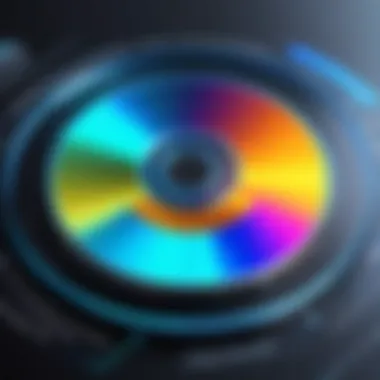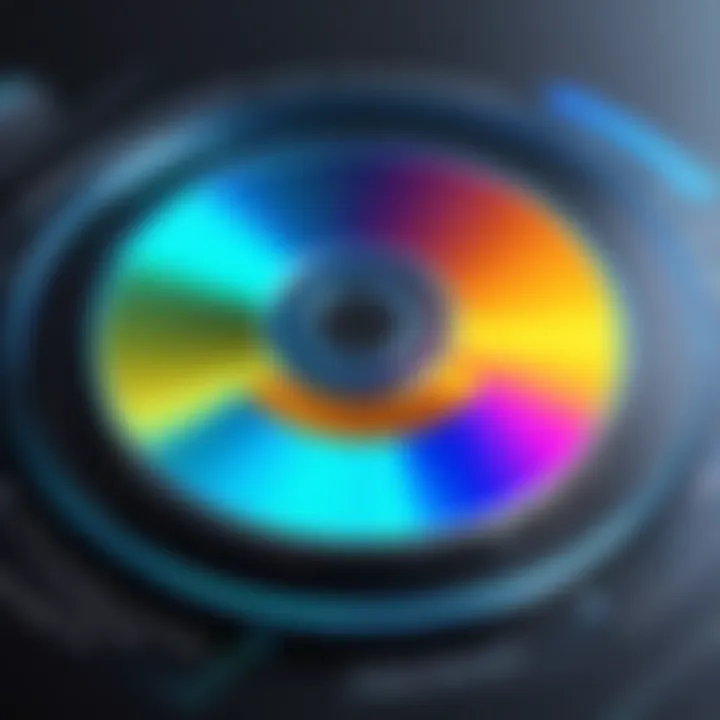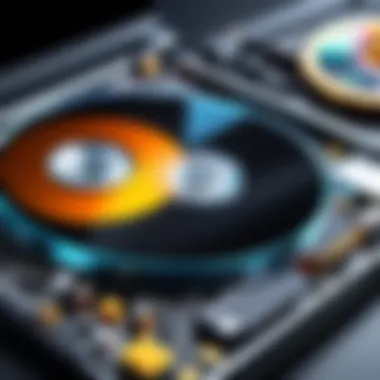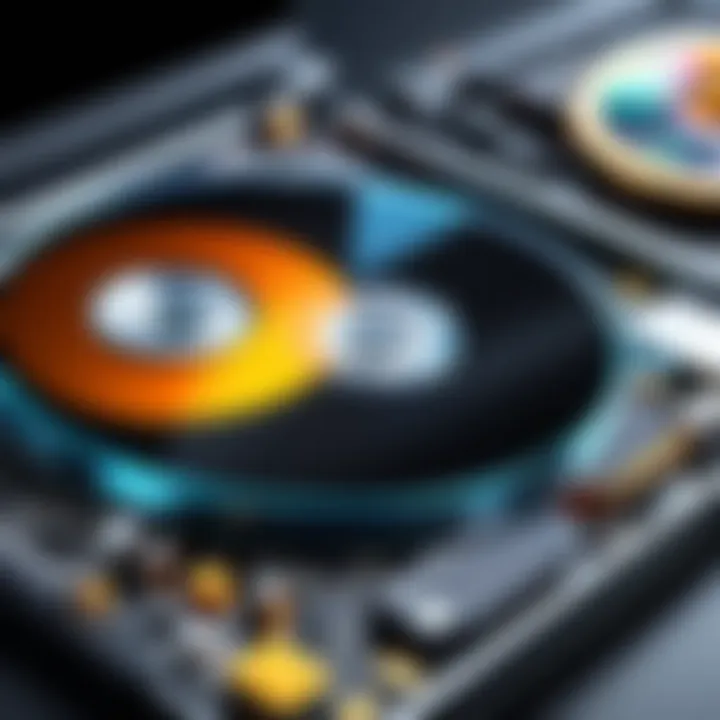How to Efficiently Copy CDs to Your Computer


Intro
The digital transformation has significantly altered how we consume and manage media. One common task many face is transferring data from CDs to their computers. For professionals and tech enthusiasts, this task might appear simple on the surface, but it encompasses various considerations and potential pitfalls. Copying CDs accurately isn't just about hitting "copy" and "paste." It requires awareness of hardware limitations, software capabilities, and, importantly, the legal landscape surrounding digital rights.
In this guide, we will embark on a thorough exploration of the nuts and bolts involved in copying CDs to your computer. We aim to equip you with essential insights, from the hardware that can aid this process to software options that ease the transfer of data. We’ll also touch on legal implications to ensure compliance with copyright laws and offer troubleshooting strategies. By the end, you should feel confident navigating this often-overlooked but vital aspect of data management in today’s technological framework.
Understanding the Basics of Copying
Understanding the basics of CD copying is fundamental in navigating the larger landscape of data transfer techniques. This section lays the groundwork for comprehending why one might copy CDs, the essential processes involved, and the implications behind this practice. It sets the tone for exploring the various aspects related to this topic, making it easier to grasp more advanced methods and tools later on.
What is Copying?
CD copying refers to the process of transferring data from a compact disc to a computer’s hard drive. This could involve audio tracks from a music CD or data files from a data CD. The primary goal is to create a usable digital version of the content found on the disc. In simple terms, it's about making a digital copy so that you don’t have to lug around physical CDs, which can be cumbersome and prone to scratches.
A few key points to consider include:
- The most common formats are audio tracks and data files.
- Copying is different from ripping; ripping typically refers to converting the format, especially with audio.
- CDs can be copied for personal use, but the legalities vary depending on jurisdiction and copyright laws.
Historical Context of Usage
The history of CDs traces back to the late 1970s and early 1980s when they were introduced as a new medium for audio storage. Initially, the CD brought about revolutionary shifts in how people consumed music. You could get cleaner sound quality compared to cassette tapes and vinyl records, not to mention the ability to integrate easily with players made for the technology.
As the 90s rolled in, data storage capacities began to expand, leading to the rise of data CDs. The emergence of the CD-R and CD-RW formats allowed users not just to play CDs but to create and rewrite them, effectively giving users control over their digital content in ways that were previously unimaginable.
Given how the digital era has evolved, CDs might seem a bit old-fashioned now, yet understanding their historical context is crucial. It informs why many still value them, or even why collectors still seek out rare items in these formats. As we charge forward into streaming and cloud solutions, it's essential to appreciate where we came from in our tech journey.
Types of CDs and Their Formats
Understanding the different types of CDs and their formats is crucial when it comes to transferring data from them. Each format serves a unique purpose, catering to specific needs and preferences. Thus, knowing the distinctions can help in choosing the right method for copying data effectively, ensuring better organization and playback quality on your computer.
Audio CDs vs. Data CDs
When we talk about CDs, the two main categories are Audio CDs and Data CDs. Audio CDs are primarily designed for storing music, adhering to the Red Book standard. This standard ensures that the audio is in a form that's playable on standard CD players, making it a cornerstone for music distribution. They hold about 74 to 80 minutes of audio content, which is a fantastic fit for entire albums or collections of singles.
On the flip side, Data CDs can store a range of files, from videos to documents, and are not limited to just audio. They come in two flavors: the standard format used for files (like .jpg or .pdf) and those that employ various compressed or non-compressed formats to save space or maintain quality. Which one to use hinges on what you're aiming to copy; for instance, if your goal is to preserve your music collection, you'd lean towards Audio CDs. If you aim to store various file types, then Data CDs are clearly the way to go.
Different File Formats Explained
When it comes to copying data from CDs, the format of the files you choose to create plays a significant role in how effectively you can manage and enjoy your media. Here’s a look at some common file formats:
WAV
WAV files are a staple in the audio world, known for their high fidelity. The key characteristic here is that WAV files are uncompressed, meaning they maintain the original sound quality without any loss. This is pivotal for audiophiles who want the clearest sound possible. Because of its lossless nature, WAV files tend to be larger than other formats, which might not be ideal for every storage situation. However, if sound quality is your utmost priority, WAV is a fantastic choice.
MP3
In contrast, MP3 files are a popular choice among casual listeners looking for convenience and portability. The unique feature of MP3 is its ability to compress audio, making file sizes much smaller. While MP3s sacrifice some quality for space, the difference is often negligible to the average listener. This format is practically ubiquitous due to its balance between size and sound quality, making it easier to store large libraries of music on computers or devices without consuming all available disk space.
CDA
CDA files, or CD Audio files, represent the tracks on an Audio CD but are not true audio files in themselves. They're pointers to the audio tracks, working as digital bookmarks rather than actual audio. The distinctive benefit of CDA files is that they allow copying of audio tracks without needing to convert them in the first step, retaining original quality. Yet, they can't be played directly outside of a CD environment, which limits their utility for storing or sharing audio. So while useful, you'll likely want to convert them into a more versatile format post-copying.
ISO
ISO files are an entirely different beast. They are images of the entire contents of a disc, including files, directories, and their structures—effectively a snapshot of the CD. This format is particularly advantageous when you aim to replicate the exact state of a CD, ensuring that everything is preserved seamlessly. The downside? These file sizes can be hefty, primarily when dealing with CDs containing significant amounts of data. Still, for those needing a foolproof backup, ISO is a vital option to consider, allowing for exact replicas without any loss of information.
"Choosing the right format is as crucial as selecting the right tool for the job. It ensures your copied data serves your needs best."
With a handle on these different formats, you’ll be better equipped to manage the copying process effectively, leading to improved organization and higher audio quality on your computer.
The Rationale for Copying CDs
When it comes to transferring music, files, or any content from CDs to a computer, one might wonder about the necessity behind this process. Many people today still cling to their trusty compact discs, even as digital formats and streaming services reign supreme. So, what's the big deal about copying these relics from another era? There are substantial reasons that underscore the importance of this practice.
Data Preservation


Preservation can’t be stressed enough when discussing the merits of copying CDs. CDs, much like fine cheese, have an expiration date. Over time, they may succumb to scratches, environmental factors, or general wear and tear that can render the data unusable. Think about it: how often have you stumbled across a loved music album only to find that it no longer plays? By transferring data to a computer, you essentially create a backup. This action keeps your cherished tunes and files safe from physical degradation.
"In the world of digital media, having a backup is like carrying an umbrella; it's better to have it and not need it than to need it and not have it."
Besides ensuring longevity, digital copies provide peace of mind. For music collectors, being able to preserve an album forever in a high-resolution format is invaluable. Moreover, when CDs are converted into digital files, they're easier to transfer between devices, share with friends, or simply enjoy without the constant worry of wear.
Access and Convenience
Besides data preservation, access and convenience represent another strong suit when it comes to copying CDs. In an increasingly mobile world, having your favorite tracks, documents, or software accessible in a digital format is no longer a luxury, it's a necessity. Why lug around a disc when it's possible to have all your needed content stored right on your laptop, tablet, or even smartphone?
The convenience extends beyond merely saving space. Consider this: accessing a single CD on a cluttered shelf might require a search that interrupts the flow of your day. On the other hand, once the data is copied, a simple search command or playlist can fetch what you want in an instant. This efficiency can also be an effective time-saver in both professional and personal contexts.
Moreover, digital files can be edited, tagged, and organized in ways that physical media simply cannot support. Just imagine having robust sorting capabilities, automatic play options, or even the ability to create custom playlists tailored to specific moods or occasions—all possible when files are converted to digital formats.
Necessary Tools for Copying CDs
To successfully copy CDs to your computer, a specific set of tools is essential for a seamless and efficient process. Understanding and selecting the right hardware and software can streamline your efforts, ensuring that you don’t run into complications. Just like assembling a recipe, each ingredient plays a vital role in the final outcome, and missing even one can lead to unsatisfactory results.
Drives: An Overview
The first necessity is having a suitable CD drive. There are two types generally found in computers today: internal drives and external drives. Internal drives are those built into desktops and laptops, while external drives connect via USB and are highly portable.
Internal CD drives are often faster because they directly interface with the motherboard. They are typically more reliable due to their fixed placement within the computer. However, if you're using a laptop that lacks a built-in disc reader, an external drive becomes a necessity. These drives are easy to use—just plug them in, and you’re good to go.
Whether you choose an internal or external option depends on your particular needs. If you mostly work from a desktop, an internal drive provides stability. But if you enjoy working on multiple devices, consider investing in a decent external drive to keep things flexible.
Software Options for Copying
Equally important is the software you select to perform the copying process. Variations abound in the tools available, each presenting unique features and capabilities. Among the most commonly used options are Windows Media Player, iTunes, and a range of third-party software solutions. Understanding the traits and limitations of these software tools can significantly affect your experience.
Windows Media Player
Windows Media Player is well-regarded for its simplicity and integration with Windows operating systems. A notable aspect is its user-friendly interface, which makes it easily navigable even for those less tech-savvy. You can rip audio from CDs directly into formats like MP3 or WAV, which is a strong point of this software.
One thing to commend about Windows Media Player is its ability to organize music files automatically. Once you select the songs, you can set it to retrieve metadata like artist names and album artwork. However, its functionality can feel limited when dealing with formats outside of standard audio discs.
iTunes
iTunes brings a different flavour to the table. Mainly popular amongst Apple users, it offers a sleek design that promotes ease of use and efficiency. One key trait of iTunes is the iTunes Store, where users can purchase new music and sync it with their libraries effortlessly. This integrated system grants users immediate access to vast audio options.
However, keep in mind that iTunes can be a little cumbersome for non-Apple users. It also has less flexibility for certain file types, as it works exceptionally well within Apple’s ecosystem but may not support everything a user might have in their collection.
Third-Party Software Solutions
Bypassing conventional software, many opt for third-party tools for CD copying. Programs like Exact Audio Copy and CDex offer additional features that some may consider superior to built-in options. A standout aspect is the precision they provide in ripping audio files, often minimizing errors while converting tracks.
The main advantage of third-party solutions lies in their versatility. They often support a wider array of formats and allow custom coding options that can further optimize the ripping process. Still, they can be a hassle to configure correctly, particularly for less tech-savvy users.
To sum up, the correct tools for copying CDs are pivotal. Choosing between drive types and software impacts not only the ease of transferring files but also helps maintain data integrity, ultimately making for a better user experience. As technology continues to evolve, so too do these tools; staying updated is key in this ever-changing digital landscape.
Step-by-Step Guide to Copying CDs
In the world of digital data, the ability to transfer information from a physical CD to your computer is essential for both preservation and access. This process is not just about moving files; it’s a blend of understanding technology and handling it with care. Whether you are archiving your music collection or extracting important data, knowing how to copy CDs can save you from future headaches. Here, we'll dive into the nuts and bolts of this procedure with clarity and precision.
Preparing Your System
Before you start the copying process, it is crucial to make sure that your system is set up correctly. Here are some important steps to take:
- Check Your CD Drive: Ensure that your computer has a functioning CD/DVD drive. You’d be surprised how many folks overlook this step!
- Update Your Software: Outdated software might lead to compatibility issues. Update your operating system and any relevant software.
- Ensure Enough Disk Space: Before actually transferring data, confirm that there’s enough space on your hard drive. Nothing’s more frustrating than running out of storage halfway through.
Performing these checks not only streamlines the copying process but can also prevent technical hiccups down the line. It’s like laying out the tools before starting a project; you’ll work more efficiently.
Using Software to Initiate Copying Process
The right software can make all the difference when it comes to copying CDs. Here’s how to get started:
- Select Your Software: Programs like Windows Media Player or iTunes are solid choices for audio CDs. For data CDs, third-party options like ImgBurn or AnyBurn can be handy.
- Load the CD into Your Drive: Insert the CD that you wish to copy, and open your chosen software immediately after.
- Follow On-Screen Instructions: Generally, the software will provide a series of prompts. Look for buttons or options that say "Copy" or "Rip". Be sure to check any settings for file formats or audio quality before hitting that all-important button.
Here's a basic example of software usage:


Using software effectively can transform a cumbersome task into a straightforward process.
Managing Storage Space on Your Computer
Once you've copied your CDs, managing the stored files efficiently is pivotal. Here’s how:
- Organize Files in Folders: Creating a specific folder for your copied CDs can dramatically reduce clutter. You might name them by artist or genre for easy access later on.
- Regularly Clean Up: If you find you have duplicated files, consider sorting through them now and again to free up space. Tools like CCleaner can help automate this by finding unnecessary files.
- Utilize External Storage: If your internal storage is running low, external hard drives or cloud services like Google Drive or Dropbox can provide great backup solutions.
"Staying organized not only makes life easier, but it also helps to protect the data you cherish."
To sum it all, copying CDs to your computer doesn’t have to be a daunting task. By preparing your system, selecting the right software, and managing your storage space, you can tackle this process smoothly.
Legal Considerations for Copying
In any realm that involves data transfer, the legal aspect tends to be the elephant in the room. Especially when it comes to copying CDs, understanding the legal environment can be a maze without a map. This section aims to illuminate why legal considerations are not merely formalities, but rather crucial elements that can impact both personal and professional usage of digital data.
Many people jump into copying CDs without a second thought, viewing it primarily through the lens of convenience. However, this oversight can lead to unexpected legal repercussions if one isn't aware of copyright laws and licensing agreements. Knowing the legal implications protects you, your organization, and your reputation in the tech world. Moreover, it ensures that you respect the rights of content creators while also strategizing your data management practices holistically.
Understanding Copyright Laws
Copyright laws serve as the backbone of any discussion about CD copying. These regulations are designed to protect the creators of original works, which include music, data files, and software found on CDs. Copyright gives the creator exclusive rights to reproduce, distribute, and sell their work. Therefore, when you make a copy of a CD, you are potentially stepping on the toes of the original creator.
In essence, most CDs come with certain restrictions. For instance, while converting music CDs into digital files can be done for personal use, distributing those files or using them for commercial purposes often runs afoul of copyright laws. This can result in hefty fines or even legal action, depending on the jurisdiction.
Some key points to remember include:
- Ownership vs. Rights: Just because you bought the CD, it doesn’t necessarily mean you can do anything you want with it. Ownership of the physical medium does not grant you the rights to reproduce the content.
- Exceptions and Variability: Different countries may have varying laws regarding copyright. For example, in some places, making a personal backup may be permissible, while in others, it might not be.
"Understanding copyright is not just for lawyers; it’s essential for anyone who engages in digital content management."
Fair Use Doctrine Explained
The Fair Use Doctrine is a legal term that allows for limited use of copyrighted material without requiring permission from the copyright owner. While the specifics can be fuzzy, especially in regards to copying CDs, there are four general factors that determine fair use:
- Purpose of Use: Non-commercial, educational, and transformative uses generally favor fair use. For instance, using a song in a classroom setting may fall under fair use. However, converting your collection into digital format for friends does not.
- Nature of the Copyrighted Work: This looks at whether the content is factual or creative. Creative works receive more protection, making it harder to justify fair use.
- Amount Used: Copying a small portion of a work can be more easily justified under fair use. Copying an entire CD? Not so much.
- Effect on Market Value: If your copying has the potential to replace the original work or harm the owner's market, it likely isn't considered fair use.
Understanding these elements not only safeguards you legally but can also structure how you approach data collection and management in your organization. Keeping you from getting into hot water is as valuable as the data you aim to copy. Embracing these legal frameworks will help ensure a responsible data strategy that respects both your needs and those of content creators.
Common Issues in Copying
When it comes to copying CDs to your computer, several challenges can arise. Understanding these common issues is essential for ensuring a seamless transfer process. Not only can troubleshooting these problems save time, but it can also protect your data and preserve your collection effectively. Knowing what to look for and how to address these issues can make a world of difference.
Troubleshooting Copying Errors
Read Errors
Read errors are a common thorn in the side when attempting to copy CDs. They happen when the CD drive is unable to read the data from the disc, which may stem from various reasons, including dirt, scratches, or even a faulty drive. The key characteristic of read errors is their frequency, making it vital for anyone aiming to copy CDs to understand how to handle them. Addressing read errors can significantly streamline the copying process, thus making it a popular focus in this article.
One unique feature of read errors is the range of software capabilities available to users. For instance, many modern CD copying software programs include built-in error correction features that can attempt to recover data even from compromised discs. However, relying solely on such features can sometimes lead to missing files, and not all errors can be corrected seamlessly. Therefore, it’s beneficial for users to not only understand the software capabilities but also to maintain their CDs meticulously and keep CD drives clean.
Scratch and Damage Management
Managing scratches and other forms of damage is crucial for preserving the integrity of a CD and ensuring successful copying. Scratches can do a number on the readability of a disc, leading to incomplete transfers or data loss. The key takeaway here is that effective management of scratches not only impacts the current copying process but also plays a role in the long-term preservation of your media.
A notable characteristic of scratch and damage management is the various methods available. From using specialized cleaners to applying DIY scratch repair techniques, there are myriad ways to mitigate damage. One unique aspect is that proactive maintenance—like storing discs away from direct sunlight or in protective cases—can prevent damage before it happens. This preventative approach can save time and resources, translating to a smoother overall experience. However, while some scratch repair methods promise results, they can sometimes backfire if not done cautiously, potentially leading to more damage.
Data Loss Prevention Techniques
Data loss is perhaps the most significant risk associated with copying CDs. The last thing anyone wants is to lose precious data during the copying process. To combat this, several techniques can be employed to prevent loss and protect digital collections.
- Regular Backups: Creating backups of your digital files immediately after transfer ensures you have copies stored securely if something goes amiss later. A good rule of thumb is the 3-2-1 backup strategy: three copies of your data, stored on two different devices, with one off-site.
- Software Validation: After copying, use verification features within the software to ensure that the data has been copied accurately. This can help catch any potential errors right away.
- Physical Disc Condition Checks: Before attempting to copy, always check the physical condition of your CDs. Discs that are free from deep scratches and dust yield better results.
Advanced Techniques for Efficient Copying
In the vast ocean of digital data management, efficient copying techniques for CDs stand out as vital tools for those looking to streamline their workflows. These methods are particularly crucial in a world where time is of the essence. As data storage needs grow, having a solid grasp on advanced techniques not only saves time but also mitigates risks associated with data loss.


Batch Copying Methods
Batch copying is all about streamlining the transfer of multiple CDs in one fell swoop. Instead of laboriously copying one CD at a time, this approach allows users to queue multiple CDs for copying, significantly enhancing productivity. Here’s why batch copying is a game-changer:
- Time Efficiency: The less time you spend on repetitive tasks, the more you can focus on value-adding activities. By queuing several CDs, you can set them to copy before stepping away, letting your computer work for you.
- Consistent Results: Copied data retains its quality across multiple copies when using the same settings. This can enhance trust in your digital library's integrity.
- Reduced Wear on Hardware: Constantly swapping CDs in and out can lead to wear on drives. A batch process minimizes that physical strain.
When you opt for batch copying, using software that supports this feature is key. Programs like iTunes or dedicated third-party solutions can automate this process without a hitch. Just make sure to monitor your storage capacity; nothing's worse than filling your hard drive mid-copying.
Using Disc Imaging Software
Disc imaging software is your safety net when it comes to creating a digital replica of your CD. Think of it as a digital photograph of the entire content of the CD. Tools like ImgBurn and PowerISO are frontrunners in this arena. By creating an image file—be it in ISO or other formats—you gain several advantages:
- Complete Copy of CD Contents: You don’t just get audio tracks; you also preserve metadata, track arrangement, and even artwork. All this details are beneficial for organizing and locating your files later.
- Faster Access: Once your data is imaged, you can access files instantly without needing to physically insert the disc. This feature is particularly handy for users who frequently reference specific tracks or files.
- Hard Drive Protection: Since your disc is a physical object, it may wear out over time. Imaging it mitigates the risk of losing access to important files due to scratches or other damage.
"Technology is a great liberator; it allows us to manage our data more intuitively and safeguard it against potential losses."
Getting started with disc imaging is straightforward. After installing your selected software, simply insert the CD, choose the option to create an image, and follow prompts until the process completes. The image file can then be stored, moved, or even burned to another CD if needed.
Both batch copying and disc imaging harness modern technology effectively, promoting a more organized and secure approach to managing CD data. As digital landscapes continue to evolve, staying ahead with these advanced techniques ensures that your data management practices remain relevant and efficient.
Best Practices for Managing Copied Files
When it comes to handling copied data from CDs, establishing effective practices is paramount. These practices ensure that your digital library remains organized and secure, reducing the risk of data loss while enabling seamless access to your files.
Organizing Digital Libraries
Having a well-structured digital library can save you countless hours of frustration. As you amass a collection of copied CDs, consider adopting a naming convention that makes sense to you. This can be the title of the music or the main subject of a CD. For example, if you are organizing audio compilations, you might label them based on the occasion, such as "Summer Jams 2022" or "Work from Home Mix."
Another crucial aspect is folder hierarchy. Group similar files within their respective folders. For instance, you could create main folders titled "Music," "Software," and "Personal Documents." Within the "Music" folder, have subfolders categorized by artist or genre; for "Software," you might have separate folders for different applications. This way, even if your collection grows large, everything is still easy to find.
In addition to categorizing your files, consider integrating a metadata tagging system. Utilizing tools that allow you to edit ID3 tags or other metadata can make sorting and searching for files more efficient. This approach gives you the ability to search for certain tracks based on criteria beyond just the file names. It broadens the scope of your organization to encompass detailed descriptions.
Regular Backups and Data Security
Backups are often thought of as an afterthought, though they really are one of the most critical components of data management. Ideally, establish a routine to back up your copied files regularly. This could be each month or after adding new content to your library. Failing to do so can lead to irreversible data loss, especially if a hard drive fails or a computer encounters a catastrophic failure.
Utilizing cloud storage solutions is highly advisable. Services like Google Drive or Dropbox not only offer additional storage but also ensure your files are securely stored off-site. If disaster strikes your local machine, you can retrieve your files, thus protecting your investment in digital data. You might also find it prudent to have a local backup on an external hard drive. This dual approach maximizes your chances of recovering important files.
Data security also extends to employing antivirus software and firewalls, which serve as your first line of defense against malware and other cyber threats. Keep software updated to fend off vulnerabilities. Ignoring updates can leave you exposed to potential risks.
"An ounce of prevention is worth a pound of cure."
This old adage rings particularly true when dealing with digital data management. By establishing effective practices now, you can save yourself countless headaches down the road.
Future of Copying in a Digital Age
In the ever-shifting landscape of technology, the future of copying CDs is a topic of both intrigue and importance. Understanding this future helps us to adapt to changes in data storage and retrieval methods. With digital consumption on the rise, the relevance of CDs appears to be waning. Yet, there remains a need to appreciate their role as we transition to newer platforms. The importance herein lies in several aspects:
- Appreciation of Legacy Media: Although many have moved on from physical media, CDs still represent a significant part of music and data history. The nostalgia associated with these formats will keep their memory alive, hence the continued interest in copying them.
- Hybrid Structures are Key: As businesses shift to entirely digital frameworks, integrating old and new systems becomes critical. Knowing how to work with CDs can bridge gaps in these systems.
- Legal Awareness: Understanding copyright implications remains essential in this digital age. Copying CDs poses legal questions, and being informed of these issues helps to avoid pitfalls.
Thus, the knowledge and skills in copying CDs will not diminish but rather evolve into strategies that respect the past while embracing the future.
Evolving Technology and Formats
The rise of digital technology brings with it a myriad of formats that go beyond the traditional CD. As more users turn to digital downloads and streaming services, different file formats and compression technologies have emerged. These advancements shape the way we copy and store data.
For instance, the distinction between lossless formats such as WAV and compressed ones like MP3 illustrates the ongoing debate over quality versus convenience. Users now have a wealth of options that can cater to specific needs:
- Lossless Formats: These are ideal for audiophiles who prioritize sound fidelity. Options like WAV and FLAC ensure every note is captured without loss of quality.
- Compressed Formats: Suitable for those who prefer ease and accessibility, MP3 remains the go-to choice due to its balance between file size and sound quality.
As the technology keeps evolving, it gives rise to newer formats, making it vital for anyone dealing with CD copying to stay updated and understand the best practices for each type of data they work with.
Impact of Cloud Storage Solutions
Cloud storage solutions continue reshaping the way we think about data management. With platforms such as Google Drive and Dropbox becoming commonplace, the reliance on physical media is steadily diminishing. However, this evolution does not make the skills of CD copying irrelevant. On the contrary, understanding how to effectively copy and transfer CD data to these cloud platforms becomes increasingly important.
- Accessibility: Storing data on the cloud virtually eliminates the need for local storage space. Users can access their files from anywhere, promoting convenience and efficiency.
- Backup Solutions: CDs can serve as an initial backup medium before transferring data to the cloud. This layered approach provides an additional safety net, ensuring that important files are not lost.
- Wireless Technologies: The emergence of services that automatically back up music and files suggests a path forward that integrates traditional methods with cutting-edge tech.
Ultimately, while physical CDs may take a backseat as technology advances, knowing how to copy them in ways that ensure seamless integration with cloud services will arm users with a solid toolkit for their data management needs.
"Navigating the realm of digital storage requires acknowledging both history and innovation; every step taken with legacy formats provides lessons for the high-speed digital year to come."
Understanding the future of CD copying amidst these advancements gives users the clarity and tools necessary to manage their digital lives effectively.
For more information about evolving formats and digital storage solutions, consider visiting resources like Wikipedia or Britannica.



